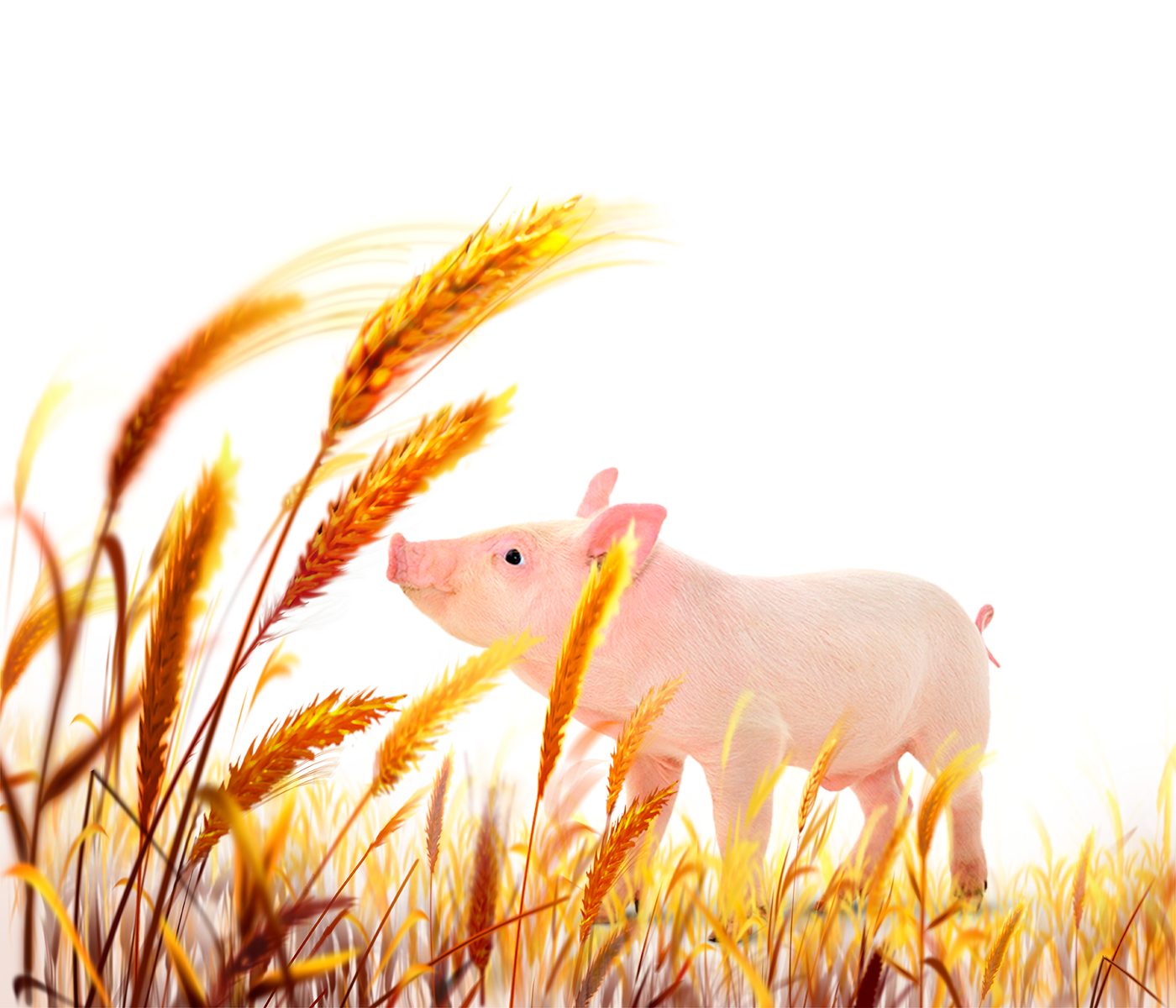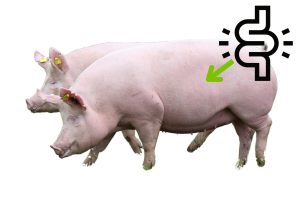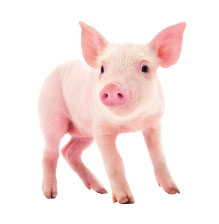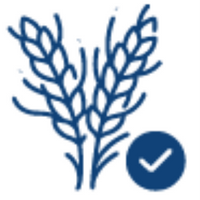 17 May 2023
17 May 2023
Dietary fiber (DF) has gained significant attention recently and its importance in pig nutrition is now well recognized.
![]() Pigs are often supplied with nutrient and energy rich diets to meet their productive requirements in a cost-effective manner.
Pigs are often supplied with nutrient and energy rich diets to meet their productive requirements in a cost-effective manner.
| The integration of fiber components into complete pig rations may require additional technical efforts and lead to faster satiety in those animals. |
The aforementioned feeding practice contradicts the natural feeding behavior of pigs,which can lead to stress and behavioral problems. The latter being considered as factors that can significantly impact animal welfare and health.
Therefore, wellness-oriented feeding concepts often include the administration of whole foods, which are rich in dietary fiber (DF) or the supply additional forage as a satiety component.
![]()
Depending on chemical composition, but in particular on microbial solubility and fermentability, liquid diets (LD) can have varying effects on pigs’ digestive tract and metabolism.
Soluble fiber (SF) sources contain mixed-bond glucans, hemicelluloses, arabinoxylans, xylogjans, galactomannans, pectins, gums, guar and agar and fructo- and indigestible galactooligosaccharides.
Partially insoluble fibers (PIFs) are composed of cellulose, lignin and different forms of resistant starches.
Dietary fiber (DF) has the potential to influence the physiology and health of sows and their litters. The effects of DF on feed consumption, and more specifically during lactation, are of special interest. Considering that higher feed intake levels during this period enhance health and performance in both sows and piglets.
In regards to reproductive performance, DF has shown to have positive impacts since the onset of puberty. This was demonstrated in first-timers fed enriched diets with soluble DF until mating. Allowing these animals to reach their reproductive maturity 15.6 days earlier.
![]()
In addition to this, their litters were characterized by being more uniform and having a reduced number of stunted piglets.
With regard to achieving successful insemination, sows fed with fiber rich diets supplemented with inulin and cellulose, sugar beet pulp (SBP), wheat bran (WB) or lupins demonstrated potentiating effects on oocyte maturity and quality. As well as exhibiting beneficial impacts on their ovarian follicle reserve.
The mechanisms behind the observed effects could be related to increased production of short-chain fatty acids (SCFAs) in the gut, increased serotonin secretion and an improved immune response based on T helper lymphocytes 2 (Th2) in pregnant sows. Exerting a positive impact on embryonic survival.
The inclusion of (13%) Ground wheat straw in gestation diets, increased litter size and total litter weight at birth, which could be related to higher feed intake.
On the other hadd, sows fed an ad libitum gestation diet with 23% WB, 20% SBP and 14% oat bran,exhibited no significant effects on their reproductive performance..
Feed intake and nutrient digestibility in sows can be influenced by high-fiber (HF) diets.

More specifically, sows which received fiber-enriched diets such as 53% corn cobs, 43% WB or 53% oat husks’, presented lower serum levels of vitamin B12 and minerals.
The observed effects could be due to the modulation of cecal and colonic vitamin B12-producing microbiota. As well as due to fiber’s mineral binding capacity and a reduction in mineral absorption time due to an increased passage rate.
Preprandial prolactin concentrations were higher with the inclusion oat straw, while postprandial insulin-like growth factor 1 (IGF-1) and prolactin increased with dietary inclusion of processed wheat straw.

Therefore, oat straw was considered to be more beneficial than wheat straw. However, the underlying mechanisms could not be further elucidated.
Surprisingly, one study showed higher levels of postprandial insulin in sows fed HF diets, containing 8% soybean husk, WB, sunflower meal and SBP. Meanwhile no effects were observed on prolactin levels.
[register]
Keeping sows in groups has a positive impact on their social behavior. However, some individuals may display aggressive behaviors which can have negative impacts on performance, well-being and health.
| The inclusion of DF has been reported to influence the behaviour of pigs. |
A trend towards less aggressive interactions and fewer fights was observed in sows fed diets enriched with different sources of fiber, such as: a mixture of grape pomace, lignocellulose and soybean husks.
More constant blood glucose levels and non-esterified fatty acids, as well as higher intestinal filling (satiety) could explain the observed effects.

Simulated chewing is considered to be a stress-related behavior in sows.
Interestingly, sows kept outdoors had increased simulated chewing when fed a diet with 25% SBP, which was not observed in sows kept indoors.
A reduction in stereotypical behaviors was observed when diets contained high DF levels of alfalfa mash (>27%) and oat husks (27%–45%).
Piglets need to to acquire passive immunity through colostrum and milk.
Therefore, feeding pregnant and/or lactating sows with certain DFs presents an attractive strategy to modulate sows’ colostrum composition, microbiota and their faecal metabolites. This can in turn have a positive impact on piglet health.

Data on the physiological impacts of DF on lactating piglets is still scarce. Piglets consuming 1% pectin-supplemented human infant formula have been shown to have a reduced ileal digestibility of DM and CP. As well as presenting lower feed intake levels and ADG, with decreased energy digestibility.
Nonetheless, lactating piglets may benefit from DF intake due to its potential to modulate early gut microbiota in a process known as “early microbial programming.” Hence, DF can have a positive impact on gut function and the health of growing animals.
The supply of liquid diets (LD) can be beneficial for early immune programming in young piglets. Which together with microbial programming present a significant tool when it comes to developing better resilience against pathogens.
Contributing towards the prevention of common health problems like intestinal dysbiosis, which leads to neonatal mortality and more commonly to post-weaning diarrhea.
Fibre-supplemented liquid diets and milk substitutes for lactating piglets have been shown to improve gut microecology and gut epithelial health.
Administration of DF in feeders for lactating piglets can be challenging due to exposure to a high load of new antigens for the developing gut. However, if it done together with the ingestion of sow milk, it may offer the opportunity to directly influence piglets’ gut microecology and health at a very early stage.
Source:
Grześkowiak, Ł, Salius, E., Martínez-Vallespín, B., Aschenbach, J., Brockmann, G., Fulde, M., . . . Zentek, J. (2023). Dietary fiber and its role in the performance, welfare and health of pigs. Animal Health Research Reviews, 1-29.
You may also like to read: “Effects of fiber and lignocellulose inclusion in piglet diets.”
[/register]
Subscribe now to the technical magazine of animal nutrition
AUTHORS

Nutritional Interventions to Improve Fertility in Male Broiler Breeders
Edgar O. Oviedo Rondón
The Use of Organic Acids in Poultry: A Natural Path to Health and Productivity
M. Naeem
Synergistic Benefits of Prebiotics and Probiotics in Poultry, Swine, and Cattle
Gustavo Adolfo Quintana-Ospina
Hybrid Rye Potential in Laying Hen Feed Rations
Gwendolyn Jones
A day in the life of phosphorus in pigs: Part I
Rafael Duran Giménez-Rico
Use of enzymes in diets for ruminants
Braulio de la Calle Campos
Minerals and Hoof Health in the Pregnant Sow
Juan Gabriel Espino
Impact of Oxidized Fats on Swine Reproduction and Offspring
Maria Alejandra Perez Alvarado